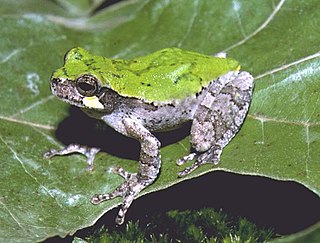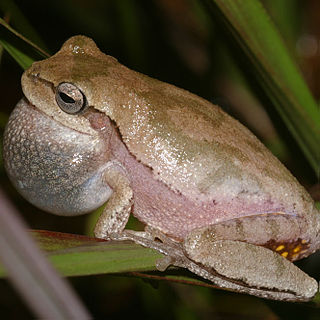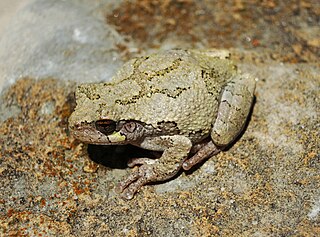
Hylidae is a wide-ranging family of frogs commonly referred to as "tree frogs and their allies". However, the hylids include a diversity of frog species, many of which do not live in trees, but are terrestrial or semiaquatic.

Hyla is a genus of frogs in the tree frog family Hylidae. As traditionally defined, it was a wastebasket genus with more than 300 species found in Europe, Asia, Africa, and across the Americas. After a major revision of the family most of these have been moved to other genera so that Hyla now only contains 17 extant (living) species from Europe, northern Africa and Asia. The earliest known fossil member of this genus is †Hyla swanstoni from the Eocene of Saskatchewan, Canada, but its designation to Hyla happened before the major revision, meaning that its position needs confirmation.

Agalychnis callidryas, known as the red-eyed treefrog, is an arboreal hylid native to Neotropical rainforests where it ranges from Mexico, through Central America, to Colombia. It is sometimes kept in captivity. The scientific name of the red-eyed treefrog, A. callidryas, comes from Greek words kalos (beautiful) and dryas.

The American green tree frog is a common species of New World tree frog belonging to the family Hylidae. A common backyard species, it is popular as a pet, and is the state amphibian of Georgia and Louisiana.

The gray treefrog is a species of small arboreal frog native to much of the eastern United States and southeastern Canada.

The Pine Barrens tree frog is a species of New World tree frog. It is becoming rare due to habitat loss.

The canyon tree frog is a species of tree frog native to the rocky plateau areas of southern United States, primarily in New Mexico and Arizona, but it also ranges to Utah, Texas, and Colorado, and as far south as the Mexican states of Michoacán, México, Guanajuato, Guerrero, and Oaxaca.

Dryophytes gratiosus, commonly known as the barking tree frog, is a species of tree frog endemic to the south-eastern United States.

Dendropsophus ebraccatus, also known as the hourglass treefrog or pantless treefrog, is a neotropical treefrog, found scattered throughout Central and South America from southern Mexico to northern Ecuador. The common names of D. ebraccatus come from the dark hourglass shaped pattern found in the centre of the back and the distinct smooth yellow thighs that contrast the rest of the brazenly patterned body. The contrasting of the smooth yellow thighs from the rest of the bodies pattern provide the illusion that D. ebraccatus is not wearing pants. The name ebraccata in Latin means "without trousers". D. ebraccatus has a number of unique reproductive features, such as the ability to alter rates of hatching shared in a number of Anura families. D. ebraccatus is also extremely unique in its ability to alter its mode of reproduction as it is the only known vertebrate to be able to do so.

The bird-voiced tree frog is a species of frog in the family Hylidae, endemic to the United States. Its natural habitats are temperate forests, shrub-dominated wetlands, and swamps.

The pine woods tree frog, is a species of frog in the family Hylidae, endemic to the southeastern United States.

Wright's mountain tree frog is a species of frog in the family Hylidae found in Mexico and the United States. Its natural habitats are temperate forests, temperate grassland, rivers, and freshwater marshes. Dryophytes wrightorum has been regarded as a synonym of Dryophytes eximius, the mountain tree frog, which is listed as the state amphibian of Arizona. As presently circumscribed, Drophytes eximius is endemic to Mexico and does not occur in Arizona.

A treefrog, or tree frog, is any species of frog that spends a major portion of its lifespan in trees, known as an arboreal state. Several lineages of frogs among the Neobatrachia have given rise to treefrogs, although they are not closely related to each other.

Hylinae is the largest subfamily of the family Hylidae, the "tree frogs". It contains nearly 700 species in 41 genera. They are generally found in North and South America, Europe, temperate Asia, and Africa north of the Sahara.
The gray tree frog is a small arboreal frog in the family Hylidae native to much of the eastern United States and southeastern Canada.
Cope's tree frog may refer to:

Dryophytes is a genus of Ameroasian tree frogs in the family Hylidae. They are found mostly in North America, but the genus also includes three species found in eastern Asia.


















